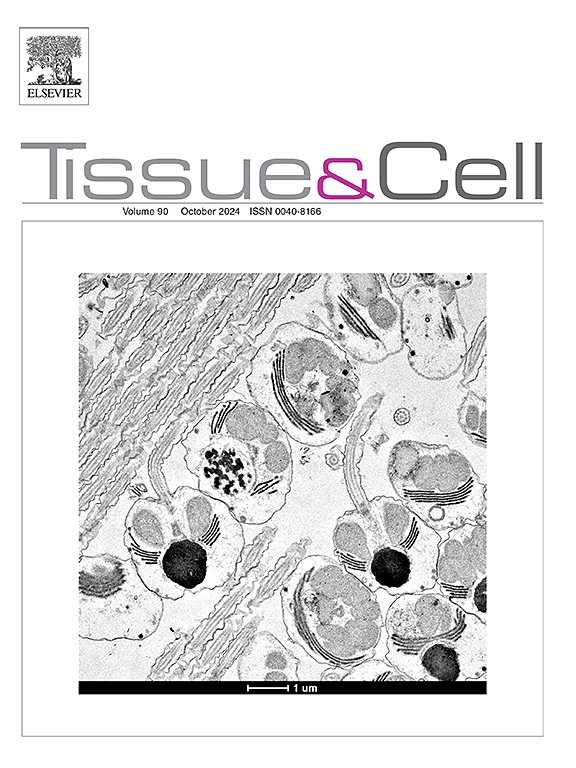通过重新定位优化血栓反应蛋白功能:对损伤和糖尿病足溃疡管理的影响
IF 2.5
4区 生物学
Q1 ANATOMY & MORPHOLOGY
引用次数: 0
摘要
糖尿病足溃疡(DFU)是一种常见且具有挑战性的糖尿病并发症,其特征是伤口愈合受损、慢性炎症、组织重塑不良和慢性炎症。血小板反应蛋白1 (TSP1)和血小板反应蛋白4 (TSP4)是参与伤口愈合的关键细胞外基质蛋白。本研究旨在评估糖尿病足溃疡中TSP1、TSP4和SOD3的水平并提出诱导因子。在本研究中,我们首先利用实时荧光定量PCR和免疫组织化学技术评估了DFU组织中TSP1、TSP4和超氧化物歧化酶3 (SOD3)的表达。在DFU组织中,我们通过实时PCR发现TSP-4的表达明显降低,免疫组织化学证实了这一点。TSP1的表达没有出现类似的变化。此外,虽然SOD3 mRNA水平在糖尿病人群中表达降低,但免疫组化未观察到蛋白水平的变化。为了探索潜在的治疗方法,我们进行了药理学重新定位,并确定了三种药物核黄素、地氯雷他定和鹅去氧胆酸选择性地增加TSP-4的表达。这些发现表明核黄素、地氯雷他定和鹅去氧胆酸可能通过特异性上调TSP4促进DFU的伤口愈合,潜在地促进组织重塑和血管生成。本文章由计算机程序翻译,如有差异,请以英文原文为准。
Optimizing thrombospondin function through repositioning: Implications for injury and diabetic foot ulcer management
Diabetic foot ulcer (DFU) is a common and challenging complication of diabetes, characterized by impaired wound healing, chronic inflammation, poor tissue remodeling, and chronic inflammation. Thrombospondin 1 (TSP1) and thrombospondin 4 (TSP4) are key extracellular matrix proteins involved in wound healing. This study aimed to assess the levels and propose inducers of TSP1, TSP4, and SOD3 in diabetic foot ulcer. In this study, we first evaluated the expression of TSP1, TSP4, and superoxide dismutase 3 (SOD3) in DFU tissues using real-time PCR and immunohistochemistry. In DFU tissues using real-time PCR we found that TSP-4 expression was significantly reduced and confirmed by immunohistochemistry. TSP1 expression did not show similar alterations. Additionally, while SOD3 expression was decreased at the mRNA level in the diabetic population, no changes were observed in the protein levels by immunohistochemistry. To explore potential therapeutic approaches, we performed pharmacological repositioning and identified three drugs riboflavin, desloratadine, and chenodeoxycholic acid that selectively increased TSP-4 expression. These findings suggest that riboflavin, desloratadine, and chenodeoxycholic acid may promote wound healing in DFU by specifically upregulating TSP4, potentially enhancing tissue remodeling and angiogenesis.
求助全文
通过发布文献求助,成功后即可免费获取论文全文。
去求助
来源期刊

Tissue & cell
医学-解剖学与形态学
CiteScore
3.90
自引率
0.00%
发文量
234
期刊介绍:
Tissue and Cell is devoted to original research on the organization of cells, subcellular and extracellular components at all levels, including the grouping and interrelations of cells in tissues and organs. The journal encourages submission of ultrastructural studies that provide novel insights into structure, function and physiology of cells and tissues, in health and disease. Bioengineering and stem cells studies focused on the description of morphological and/or histological data are also welcomed.
Studies investigating the effect of compounds and/or substances on structure of cells and tissues are generally outside the scope of this journal. For consideration, studies should contain a clear rationale on the use of (a) given substance(s), have a compelling morphological and structural focus and present novel incremental findings from previous literature.
 求助内容:
求助内容: 应助结果提醒方式:
应助结果提醒方式:


